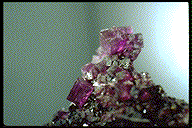
- Chemistry: PbClOH, Lead Chloride Hydroxide.
- Class: Halides
- Uses: As a very minor ore of lead and as mineral specimens.
Specimens
Laurionite is a rare halide mineral. It is polymorphous
with another mineral;
Both minerals are found in lead slags at only a few localities in the world. Slags are the debris left over from previous mining operations. These slags are generally thought by the miners to be of such low grade ore that they are simply discarded. Often these slag piles are later reclaimed for their now more valuable metals by modern techniques that can extract profitable amounts of metal from these lower grade ores.
Mineralogists often consider these slag piles to be valuable as collecting sites for rare and sometimes unknown minerals. Such is the case for laurionite and paralaurionite. Although both have been known for over a century, like them, many minerals were and are being discovered in lead slag piles, sometimes leftover from mining operations that stopped centuries before.
Laurionite forms small colorless vitreous to adamantine crystals often with distinctive V-shaped striations on the prism faces. Crystals are prismatic to acicular and brittle. Paralaurionite forms minute tabular colorless, white or pale yellow crystals without striations and they are nonbrittle, flexible but inelastic.
PHYSICAL CHARACTERISTICS:
- Color is colorless to white.
- Luster is vitreous to adamantine.
- Transparency crystals are transparent to translucent.
- Crystal System is Orthorhombic.
- Crystal Habits include striated crystals that are prismatic to acicular with sharply pointed terminations.
- Cleavage is almost indiscernible in one direction.
- Fracture is uneven.
- Hardness is 3 - 3.5
- Specific Gravity is approximately 6.1 to 6.2+ (very heavy for translucent minerals).
- Streak is white.
- Other Characteristics: Crystals are striated with distinctive V-shapes on prism faces and crystals are brittle unlike those of the closely related paralaurionite.
- Associated Minerals include fiedlerite,
cerussite,
penfieldite ,matlockite , phosgenite andparalaurionite. - Notable Occurrences are limited to Laurion, Greece (hence the name) and Wheal Rose, Cornwall, England.
- Best Field Indicators are crystal habit, associations, striations, brittleness and localities.





